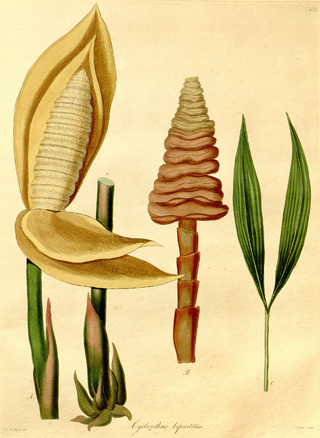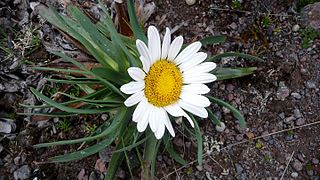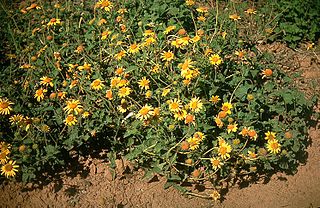
Eduard Friedrich Poeppig was a German botanist, zoologist and explorer.

Tetrorchidium is a genus of flowering plants in the family Euphorbiaceae first described in 1841. It is native to tropical portions of Africa and the Western Hemisphere.

Dalechampia dioscoreifolia is a species of plant in the family Euphorbiaceae first described in 1841. It is native to Central America and northern and western South America.

Munnozia is a genus of flowering plants in the family Asteraceae. It is centered in the Andes.
Plagiocheilus is a genus of flowering plant in the family Asteraceae. It is now classified in tribe Astereae, but used to be placed with the Anthemideae.

Cyclanthus is a genus of plants in the family Cyclanthaceae, first described as a genus in 1824. It is native to tropical Latin America and the West Indies. It consists of large, palm-like monocots.

Cyclanthus bipartitus a species of plant in the family Cyclanthaceae, first described as a genus in 1824. It is native to southern Mexico, Central America, Trinidad, Windward Islands, northern South America.

Comparettia, abbreviated Comp in the horticultural trade, is a genus of orchids. It consists about 50-70 species, native to tropical America. They occur in Mexico, Central America, the West Indies, and in northern South America as far south as Brazil and Bolivia, although they are particularly common in the Andes. The genus has grown markedly in recent years due to many species being transferred from other genera.

Nassauvia is a genus of flowering plants in the tribe Nassauvieae within the family Asteraceae. It is native to Argentina, Bolivia, Chile and the Falkland Islands.

Epidendrum compressum is a species of orchid in the genus Epidendrum from wet montane forests of Trinidad, Venezuela, Colombia, Ecuador, Peru and Bolivia.

Werneria is a genus of South American plants in the groundsel tribe within the sunflower family.

Tridax is a genus of flowering plants in the family Asteraceae.

Hymenostephium is a genus of flowering plants in the family Asteraceae. It includes herbs and slender shrubs that occur from Mexico through to Venezuela and north-western Argentina.

Simsia is a genus of flowering plants in the tribe Heliantheae within the family Asteraceae. It includes annuals, herbaceous perennials, and shrubs. They range from the western United States south through Central and South America to Argentina, with the center of diversity occurring in Mexico. The genus is named for British physician and botanist John Sims (1749–1831). Although some species are relatively rare, others have become common weeds that line the roadsides and fields of Mexico, often forming dense stands mixed with Tithonia and other Asteraceae. Some species are known by the common name bushsunflower.
Mniodes is a genus of South American flowering plants in the tribe Gnaphalieae within the family Asteraceae.

Tristagma is a genus of South American plants in the onion subfamily with the Amaryllis family. It is native to South America but one of the species (T. uniflorum) has become naturalized in various other places.

Philibertia is a genus of flowering plants in the family Apocynaceae, first described as a genus in 1819. It is native to South America.
Oriastrum is a genus of plants in the sunflower family, found only in the Republic of Chile in South America.
Xiphochaeta is a genus of South American plants in the tribe Vernonieae within the family Asteraceae.
Cupania cinerea is a plant species in the family Sapindaceae. It was described as a new species in 1843 by German botanist Eduard Friedrich Poeppig. The plant is native to South America and Central America.














